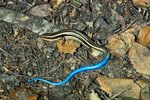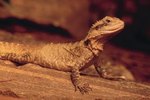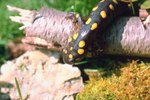
Also known as Burton's legless lizard, the New Guinea legless lizard (Lialis burtonis) is endemic to Australia and New Guinea. The legless lizard, a member of the Pygopodidae family, ad resembles a snake in appearance. The Pygopodidae is not truly legless; he has no forelimbs and sports vestigial hind flaps that he uses for movement, courtship and defense.
Description
The New Guinea legless lizard can be distinguished from a snake by the presence of a fleshy and non-forked tongue, eyelids that can move, ear openings on either side of the head and vestigial hind flaps that occur where the tail begins to taper. The New Guinea legless lizard has a uniquely wedge-shaped nose and small, irregular head scales. Specimens range in color from beige to red and may have stripes or spots.
Habitat
House your New Guinea legless lizard juvenile in a 10-gallon aquarium and establish a larger cage for his adulthood. He'll need a reptile cage or vivarium that is, at minimum, as long as he is. The New Guinea legless lizard can grow to be 3 feet in length; so plan for something at least that long in his habitat. Fill your New Guinea legless lizard's habitat with live plants, plenty of room to move and fresh water. Include a basking spot with a heat lamp, an absorbent substrate such as cypress or coconut mulch, multiple perches and plenty of places to hide.
Diet and Feeding
The New Guinea legless lizard should never be contained with other lizards or snakes; the legless lizard is an obligate lizard eater who will kill and consume any other reptile tank mates. Feed a New Guinea legless lizard a diet of live feeder lizards once a week. Keep a large reptile water bowl in the tank at all times, and mist the entire habitat twice a day. If your vivarium supports running water, such as a waterfall, make sure it is clean and shallow.
Tips and Tricks
Do not let the temperature in your New Guinea legless lizard's habitat drop below 70 degrees Fahrenheit. Use a red light bulb for warmth at night when the basking lamp is switched off. Try online resources for ordering live lizards for your New Guinea legless lizard if local pet shops prove insufficient. You can use an electric fogger to replace misting by hand for both convenience and aesthetics. The New Guinea legless lizard is crepuscular, meaning he is active mostly at dawn and dusk.
References
Resources
Photo Credits
-
Photos.com/Photos.com/Getty Images



